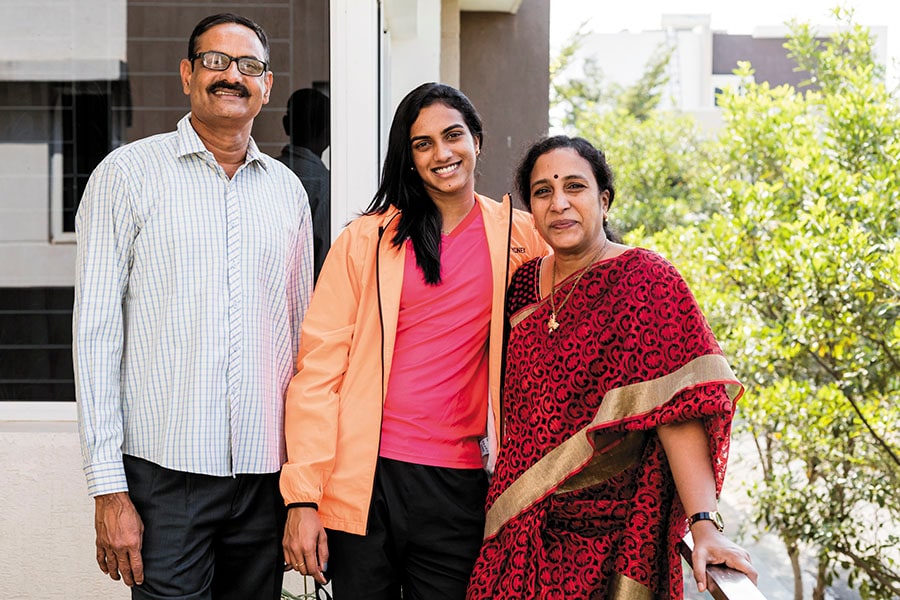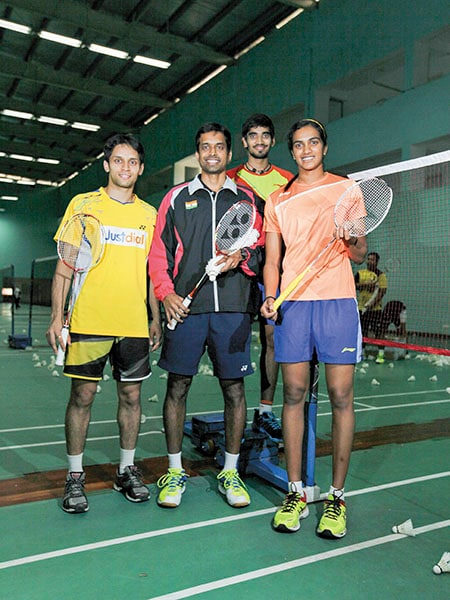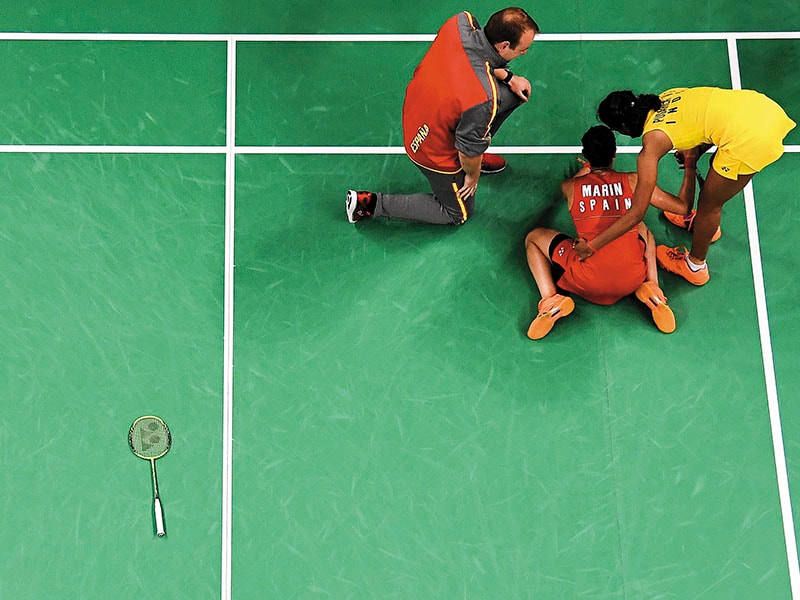
PV Sindhu: Making feathers fly
At 22, shuttler PV Sindhu has had podium finishes at all top international competitions, including the 2016 Olympics. And she's just getting started
 Forbes India Celebrity 100 Rank No. 13
Forbes India Celebrity 100 Rank No. 13Image: Reuben Singh / Hindustan Times via Getty Images
It’s a slow morning at a five-star hotel in Nagpur, where the country’s badminton fraternity has gathered for the 82nd Senior Nationals. In the lobby, a help desk is left unmanned for the most part, some camera-toting journalists amble aimlessly, and players, Kidambi Srikanth and HS Prannoy (World No 4 and 10 respectively) included, saunter into the breakfast hall without much fanfare. Only a few shuttlers scurry to catch the next car to the stadium, invoking a sense of urgency that is typical of a semifinal day.
A little after 10.30 am, a car stops at the porch and out steps PV Sindhu, World No 3 and India’s top shuttler, back from her morning practice. In one stroke, the entire hotel lobby springs to its feet, flashes pop like corn and requests for sound bites are hurled in the air. A crowd conjures out of nowhere, phone cameras flip into selfie mode and kids with autograph books run with the people thronging her 5’11’’, lithe frame.
Sindhu obliges all, sometimes even doubling up to fit into the photo frame. At 22, she is no stranger to the frenzy once accorded only to cricketers. Ever since she brought back silver from the 2016 Olympics in Rio, losing the final to Spaniard and then World No 1 Carolina Marin, she burst on to national consciousness like a young Sachin Tendulkar did on his 1989 tour to Pakistan, with his imperious defiance of the Wasims and the Waqars.
Sindhu followed up the silver with her first Superseries win in China and victories at the India Open and Korea Open this year. But what turned social media buzz and conversations about the Hyderabadi into mass hysteria was the 2017 World Championships final against Japanese Nozomi Okuhara: A lung-ripping, emotionally-sapping, see-saw encounter that, at 110 minutes, was the second longest duel in the history of women’s singles. A match, with a 73-shot rally, that Indonesian World No 6 Ratchanok Intanon dubbed “history making for women’s singles”. Sindhu lost by two points, but gave sporting grit and fortitude a new definition. Just like PT Usha did with her stirring sprint in the 1984 Olympics, or gymnast Dipa Karmakar with her audacious Produnova vault in 2016, that scripted history but fell just short of a medal.
 Left: Sindhu’s parents, Ramana and Vijayalakshmi, were national-level volleyball players
Left: Sindhu’s parents, Ramana and Vijayalakshmi, were national-level volleyball playersImage: Harsha Vadlamani for Forbes India
Sindhu isn’t India’s first global icon in badminton. It was Prakash Padukone, who, in 1980, put India on the world map by winning the All-England Championships and becoming World No 1. Two decades later, in 2001, Pullela Gopichand, now Sindhu’s mentor, repeated the All-England feat. In 2012, Saina Nehwal, a trainee at an academy run by Gopichand, brought the country its first badminton Olympic medal (a bronze). Nehwal later reached the No 1 rank as well (while training with Vimal Kumar; she has subsequently returned to Gopichand). Besides, players like Chetan Anand and Aparna Popat bolstered Indian presence on the international stage through the ’90s and the noughties, hovering around the top 10 rankings.
But what set Sindhu apart from the others, barring Nehwal, was her Olympic feat. India’s fascination for Olympic glory can be gauged by the fact that Sindhu’s consecutive bronze medals at the World Championships in 2013 and 2014 failed to create a buzz similar to her Rio show. Her Olympic podium finish at the age of 21 not only reinvigorated a country that was resigned to returning empty-handed from Rio, but also helped her step out of Nehwal’s shadows definitively.
The performance brought home for Sindhu cash rewards and incentives that were hitherto reserved only for cricketers. In the period between October 2016 and September 2017, she earned ₹19 crore (including prize money and grants), and lapped up 16 brand endorsements (worth between ₹70 crore and ₹80 crore), next only to Virat Kohli, currently Indian cricket’s man with the Midas touch. “Life has changed completely in the past year. I can’t go out and shop, I get mobbed. At movie theatres, I have to leave before the lights are back. But,” she adds as an afterthought, “I quite enjoy it. It feels nice.”
Sometimes, this candour is a refreshing reminder of how young Sindhu is; a fact that her long list of achievements tends to bury. Shorn of those, she would be just another MBA student at St Anne’s College, a degree she is pursuing alongside badminton. Her easy, uncomplicated nature is reiterated when she discusses, among other things, her love for Paris, junk food—ice cream, pizza, burgers, what have you—and mobile phones. “I wonder how I gave up my phone for three months before the Olympics, when Gopi Sir asked for it,” she says, rolling her eyes. “I must have been in the zone at that moment, because I had instantly said yes.”
 The shuttler with mentor P Gopichand (second from left)
The shuttler with mentor P Gopichand (second from left)Image: Raj K Raj / Hindustan Times via Getty Images
But it’s this self-effacing persona that Gopichand had to work hard on for Sindhu to curb on the court. “Off the court, she is one of the nicest persons you’ll ever meet. That sometimes would stop her from being super-competitive,” he says. It’s part of sporting lore how, one fine day, Sindhu landed up for training and Gopichand refused to let her play till she stood in the middle of the court and let out one roar after another.
“On-court aggression isn’t just about gaining an advantage; it can be quite cathartic,” says Shree Advani, a mind coach who worked with Sindhu in 2013 and 2014. “What I first started noticing about her was that she was more vocal on court when she committed an error and was more subdued and quiet when she won points. We had to work on reversing that.” Heartwarming images of Sindhu picking up Marin and her racket at the end of the loss in the Olympic final may be reminiscent of the genial person she is, but infused in that character now is a combative streak that lets out a roar or a searing “I’m-that-good” look at her opponent every time she hits an impeccable drop or makes an impossible retrieve.
While her on-court belligerence is new-found, Sindhu has always been a fighter. Her compatriot and men’s world No 4 Kidambi Srikanth, who has grown up playing with her, vouches for it. “We’ve played together since the juniors and Sindhu hasn’t ever lost any match for want of a fight,” says Srikanth. It’s also an attribute that defines her brand value and has helped her cobble together a name even beyond her Olympic success, says brand consultant Harish Bijoor.
Perhaps such on-court spunk is only too natural for Sindhu, the daughter of Ramana and Vijayalakshmi, both national-level volleyball players. Ramana, in fact, was part of the team that won bronze at the 1986 Asian Games and was an Arjuna awardee in 2000, a recognition that his daughter would also earn in 2013.
 Sindhu lost to World No 1 Carolina Marin at the 2016 Olympics, but her gesture of picking up the Spaniard and her racket after the loss won her many admirers
Sindhu lost to World No 1 Carolina Marin at the 2016 Olympics, but her gesture of picking up the Spaniard and her racket after the loss won her many admirersAs a child, Sindhu would accompany her father to the volleyball court and, just for fun, fiddle with the badminton racket at the court next door. As she took to the game, her parents encouraged her to pursue it. “Many people ask me why badminton and not volleyball. My father appreciated badminton because it was an individual sport and only you can control its result,” says Sindhu.
Sindhu started formal training with Mir Mahboob Ali when she was eight-and-a-half, and, at 10, shifted to the Gopichand Academy that offered a larger pool of sparring partners. That meant a punishing daily schedule of waking up at 4 am, commuting about 28 km from her home in Secunderabad to Gachibowli, where the academy was located, returning home for school and rushing back to practice once school got over. It would often be 10 pm before she would return home.
But Gopichand, known to be an exacting taskmaster, spotted the talent powerhouse that Sindhu was and not only ensured that she stuck to the schedule but, in 2010, asked her to arrive an hour earlier so that he could spend more time with her. “The first thing you notice about her is that she would keep on fighting till the end. It was clear that she would be the next big thing in Indian badminton,” he says. “In terms of her athletic physicality, there were signs that she would become a tall, lanky player. So we made her train accordingly, started working extra on her strength so that she had a low centre of gravity and could remain steady at that height,” says Gopichand.
“ When I used to play the top guns, I had nothing to lose. Post-Rio, there is a lot of responsibility.”
The gruelling routine yielded results soon. In 2012, Sindhu defeated reigning world champion and Olympic gold medallist Li Xuerui of China at the China Open Super Series. For perspective, imagine a 17-year-old beating Roger Federer in his own backyard. And then came the two bronzes at the consecutive World Championships, where she outclassed Wang Yihan and Wang Shixian, who were part of the Chinese ‘Wall’ that dominated world badminton. “At that time, when I used to play the top guns, I had nothing to lose. I went into these matches with the mindset of giving my best. But now things have changed. Post-Rio, I am a lot more confident, but there is a lot of responsibility to do well too,” says Sindhu.
Is this sense of responsibility proving to be a tad too onerous? While her close losses to Marin and Okuhara at the Olympics and the World Championships, respectively, have attracted questions about her finishing ability, Sindhu isn’t doing herself a favour by losing matches where she’s the favourite and to opponents she has beaten before. Consider her tame defeats to Chinese qualifier Gao Fangjie in the quarterfinals of the China Open, where she was the defending champion, and to Japanese Akane Yamaguchi at the French Open. Or the loss to Okuhara, whom she had beaten handsomely in the Olympics semifinal.
Nine-time national champion Aparna Popat, though, isn’t worried. The nature of the game has evolved over the past several years, she believes, shutting off the Susi Susanti-style domination of the ’90s. “Women’s badminton today,” she says, “is just like women’s tennis, with a global representation and an open field. It’s difficult for one person to dominate. How do you sustain yourself amid such stiff competition? Just keep playing and adapting. Credit to Sindhu’s team for helping her peak at the right time. To continuously do well at big events is a great thing.”
Gopichand, too, doesn’t read much into the claims of inconsistency: “She’s 22 and already has three World Championships, Olympics, Asian Games, Commonwealth and Superseries medals. I don’t mind the occasional losses if she can produce such results. At the end of the day, I don’t expect her to win every match and tournament she plays.”
Clearly, Gopichand is betting on Sindhu as the big-match player. But, with competition heating up, she will have to transform into a giant-slayer in every match if she has to upgrade her medal at the Tokyo Olympics in 2020. And a billion Indians are betting on that.
(This story appears in the 30 November, -0001 issue of Forbes India. To visit our Archives, click here.)
X





